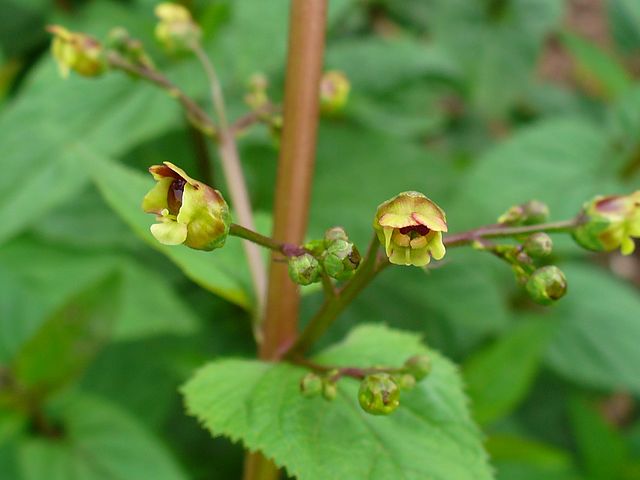 |  |  |   |  |
 |  |
Figwort is a perennial plant with a rubbery-aged root. The stem is erect, four-sided, up to 1.5 m long. When the plant is crushed, it smells unpleasant. The leaves are ovate, rarely elliptic, sharply toothed along the edge. The leaves grow 20cm long and 10cm wide. The flowers are greenish-brown, arranged in a craggy, pyramidal, small raceme. The fruits of the Figwort are pointed, naked round boxes, up to 10 mm long, up to 5 mm wide. They contain tiny, elliptical, dark brown seeds.
Rhizomes, juice and leaves are collected for medicinal purposes. Lilacs are harvested during flowering. The plant blooms in June-September. Collect the tops of the leaves, dry them by spreading them in a thin layer, in a well-ventilated place. It is good to know that the plant is poisonous and it is better not to dry it indoors. The juice of the plant can cause skin irritation, so work with it only with rubber gloves.
The rhizomes are dug in autumn, when the surface part of the plant has died. The rhizomes are carefully cleaned from the soil, rinsed with cold water, cut into slices and dried in the same way as scallions.
The obtained drug and preparations made from the plant are stored in hermetic containers, away from heat sources and sunlight, as well as in a place inaccessible to children.
Figwort has been studied enough from a chemical point of view. It has been established that laksa contains vitamin C and pectin substances. Sugar, choline, saponins, flavonoids and coumarins are found in the rhizome. Both licorice and rhizome contain organic acids, including fatty acids, malic acid, succinic acid, resins, tannins, alkaloids, flavonoid hesperidin and iridoids.
Medicinal significance
The medicinal properties of this plant were determined after many clinical tests conducted by Chinese scientists. They determined that the plant has powerful pain-relieving properties with virtually no side effects. Figwort extracts reduce edema, infiltration and proliferation of activated T-lymphocytes in joint tissue, as well as inhibit inflammation. In this way, scientists determined that Figwort may be a promising remedy for joint arthritis.
Figwort gum has been used in folk medicine for centuries. The rhizomes are recommended to be used orally in case of joint rheumatism, itching and lymphadenitis. With poultices of Figwort gargle the throat to treat angina.
Freshly squeezed juice and decoctions of the plant are drunk in cases of lipoma, malaria, joint arthritis, otitis, thyroid gland diseases, infiltrates and neoplasms. Infusions and decoctions are used as a sedative, recommended for headache and insomnia. Externally, the setting is used for the treatment of skin rashes, inflammation of lymph nodes, furunculosis, itchy dermatoses. Applications are made from the plant to treat abscess and hemorrhoids.
